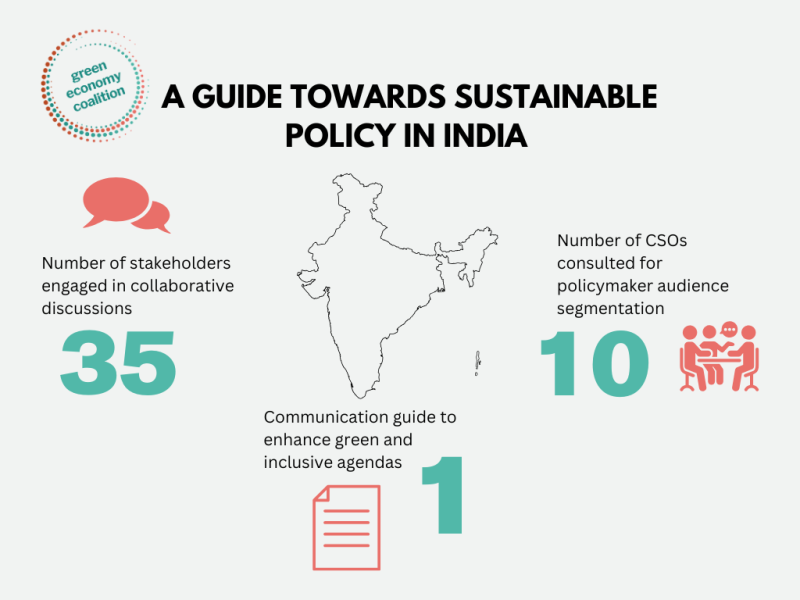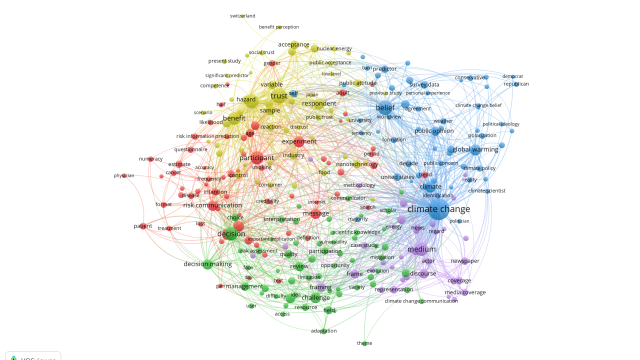A guide towards sustainable policy in India
Delve into audience and narrative research carried out by our partners Development Alternatives to promote green inclusive agendas in India

In collaboration with our partners Development Alternatives (DA) in India, Libélula in Peru and ACODE in Uganda, in 2024 the Green Economy Coalition delved deep into audience and narrative research to support the transition to a just, green and circular economy. Over 8 months, the three local hubs brought together separate stakeholder coalitions to identify critical audiences – all with the aim of promoting inclusive green economies.
The work generated numerous insights and some surprising findings and provides a detailed and logical kit for campaigners to work to influence policymakers, including valuable tools and proven methodologies for driving green economic policymaking.
It’s all in the policy, but communication is key
DA was able to develop in depth and targeted guidance by focusing on one target audience in the timeframe of this project. However, feedback from CSOs suggested taking a more holistic approach to audience selection. They saw value in involving other critical audiences, such as those from the private and finance sectors and technology experts, rather than solely focusing on policymakers.
A guide to understanding how to access and engage a range of sectors would be beneficial, fostering a more joined up approach. It is also important to recognise and design strategies to involve secondary audiences or others in the policy ecosystem who can influence policy makers, for example, to draw on when policy makers are unresponsive. Additionally, expanding focus to MSMEs as an important audience added value to the process. These important lessons provide valuable insights and will shape the design of our future work.
The timeframe of this project created some restrictions in scope and longevity. While 8 months provided enough time for research, convening and guide development, more time would have allowed proper dedication to guide dissemination and encourage implementation. This would have allowed for better focus on long-term systemic change by improving reach and engagement.
DA found that critical work still needed to be done around awareness building of green concepts, such as ‘green economy’ and ‘small and micro enterprises’. Sensitising stakeholders requires strengthening their understanding over time and the guide emphasises the importance of knowledge sharing.
DA decided on decision makers/ policymakers as a target audience, perhaps due to the context they were working in and the power dynamics in country. As such, the work was very much dependent on the government's agenda and responsiveness, including policymakers readiness and capacity to deliver change. This reinforces the need for adaptability in building alliances and taking a multi-stakeholder approach to influence at other levels. Again, more time would have allowed further engagement to create an inclusive culture of policy and advocacy work, where diverse voices could be heard.
The hubs found the stakeholder mapping exercise very valuable, particularly if approached in an iterative way, and will be incorporating it into future work. Interestingly, in tumultuous times hubs have found it easier to operate at a local level, where 1-2-1 relationships and influence is more accessible and tangible. Overall, DA have developed a comprehensive and practical guide that now offers advice and inspiration for CSOs and other campaigners to creatively revitalise their approach to policymakers to enhance green and inclusive agendas.

Finding a critical audience is good, finding the right audience is critical
DA was able to develop in depth and targeted guidance by focusing on one target audience in the timeframe of this project. However, feedback from CSOs suggested taking a more holistic approach to audience selection. They saw value in involving other critical audiences, such as those from the private and finance sectors and technology experts, rather than solely focusing on policymakers.
A guide to understanding how to access and engage a range of sectors would be beneficial, fostering a more joined up approach. It is also important to recognise and design strategies to involve secondary audiences or others in the policy ecosystem who can influence policy makers, for example, to draw on when policy makers are unresponsive. Additionally, expanding focus to MSMEs as an important audience added value to the process. These important lessons provide valuable insights and will shape the design of our future work.
DA decided on decision makers/ policymakers as a target audience, perhaps due to the context they were working in and the power dynamics in country. As such, the work was very much dependent on the government's agenda and responsiveness, including policymakers’ readiness and capacity to deliver change. This reinforces the need for adaptability in building alliances and taking a multi-stakeholder approach to influence at other levels. More time would have allowed further engagement to create an inclusive culture of policy and advocacy work, where diverse voices could be heard.
Lessons learned and a view to the future
The timeframe of this project created some restrictions in scope and longevity. While 8 months provided enough time for research, convening and guide development, more time would have allowed proper dedication to guide dissemination and encourage implementation. This would have allowed for better focus on long-term systemic change by improving reach and engagement.
DA found that critical work still needed to be done around awareness building of green concepts, such as ‘green economy’ and ‘small and micro enterprises’. Sensitising stakeholders requires strengthening their understanding over time and the guide emphasises the importance of knowledge sharing.
The hubs found the stakeholder mapping exercise very valuable, particularly if approached in an iterative way, and will be incorporating it into future work. Interestingly, in tumultuous times hubs have found it easier to operate at a local level, where 1-2-1 relationships and influence is more accessible and tangible. Overall, DA have developed a comprehensive and practical guide that now offers advice and inspiration for CSOs and other campaigners to creatively revitalise their approach to policymakers to enhance green and inclusive agendas.
- Zaiza Khan, GEC


